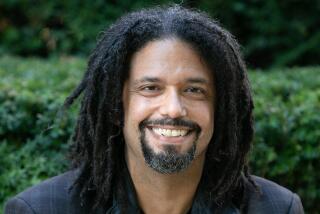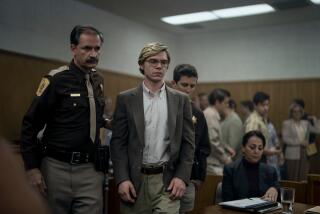The Reality of Race
- Share via
“The value placed on the color of the skin is always and everywhere and forever a delusion,” James Baldwin said in 1976. And yet, as four recent books on race make clear, this country is obsessed with race and skin color.
Matthew Pratt Guterl’s “The Color of Race in America, 1900-1940” shows the utter arbitrariness of racial categories. Even the label “white” has changed its meaning over time. In the years leading up to World War I, the steerage sections of ships to New York were packed with immigrants--Irish, Eastern European Jews and southern Europeans. They were not Anglo-Saxons and, therefore, according to the racial taxonomy of the time, they were not “white.” Northerners worried a great deal about these aliens and their effect on Nordic American stock. They gave little thought to African Americans: They were a Southern problem.
During World War I, European immigration stopped. African Americans were encouraged to move north to fill the employment gap. From 1916 to 1928, during the Great Migration, 12 million black Southerners made their way to Northern industrial cities. Northern phobias changed. In 1920, everyone was reading Lothrop Stoddard’s racist book, “The Rising Tide of Color Against White World Supremacy.”
That was the year the United States Census Bureau dropped the “mulatto” category. Americans with the slightest drop of African blood, whatever their color, were called “black.” As part of the same process, people of Irish, Jewish and Mediterranean heritage became “white.”
Progressives like W.E.B. Du Bois were hopeful that the Great Migration would eventually bring about a genuine melting pot. He foresaw a time when blacks would disappear into the mass of Americans in the same way the Irish and Scandinavians and Italians had done, a time when the word “race” would no longer be useful. He was to be bitterly disillusioned. During the late 1920s, Northern cities became increasingly segregated. Race riots flared up. Du Bois came to the conclusion that white supremacy was built into the psyche of white people. He and his wife migrated to Ghana.
“Better Day Coming,” Adam Fairclough’s survey of the struggle for civil rights, echoes the spiritual hymn “Dere’s a better day com’, Don’t you get weary.” However, it’s hard to be optimistic in the face of 11/2 centuries in which whites have constantly subverted black progress. As Fairclough writes: “Blacks usually took one step forward only to find themselves two steps back.” His book makes poignant reading.
A professor of American history at the University of East Anglia in England, Fairclough argues that, though militant confrontation appears more courageous and heroic, some important gains have come from strategies which appear to be compromises, like Booker T. Washington’s stance as an accommodationist. In the 1880s, Washington established Tuskegee Institute in Alabama in the face of deep-seated opposition to black education from Southern whites. Washington’s critics--most famously Du Bois--always condemned Tuskegee’s “industrial education,” with its manual labor orientation, as a training in inferiority. Fairclough sees Washington’s project as more subversive. According to him, while Southern whites saw “industrial education” as a way of keeping blacks down, Washington quietly used it to raise them up.
In the black community, Washington is generally regarded as the paradigmatic black sellout. Former President Clinton, on the other hand, has been systematically championed. And Fairclough is much tougher on Clinton than he is on Washington. As Fairclough sees it, Clinton has betrayed blacks. Promising to “end welfare as we know it,” he signed a bill that ended aid to families with dependent children, turned welfare over to the states and severed people from the welfare rolls after two years. He supported the “three-strikes” laws, which hugely increased America’s disproportionately black prison population.
Fairclough does not say much about the vast gulf between the black middle class and the black underclass, but he does point out that the “black community” is no longer a single entity and that, because of this, black leaders are no longer clear about how best to mobilize against racism. “More than thirty years after the death of Martin Luther King, the next road--the right road--is hard to discern.”
And for Bob Blauner, this sentiment is equally true. Blauner, a retired UC Berkeley sociologist, is dismayed that essays he wrote to explain American racial oppression in the late 1960s in “Racial Oppression in America” are considered just as relevant today. Racism in this country, he writes, is like “a gritty old boxer who just won’t stay down.” His “Still the Big News” is a revised and expanded edition of that earlier book.
Why does racism persist? According to Blauner, the founders of modern sociology--Marx, Weber, Durkheim--all predicted that racial and ethnic allegiances would disappear as traditional societies gave way to modern industrial societies. Twentieth century American sociologists were convinced that modern social stratification would be based on class, not race. They were wrong. Blauner’s conclusion is that racial oppression is an indispensable element of American society. If the majority of the population benefits from white supremacy, why would this majority care about the moral issues?
Blauner’s vocabulary on race has changed since the late 1960s, and several of his formerly contentious arguments (such as the claim that there is a distinct Afro-American culture) have become widely accepted today. The academy itself has clearly changed. (In the ‘60s, Blauner, painfully conscious of the exploitative nature of his role as a white scholar working on black subject matter, did his best to incorporate social action into his academic research.) What has not changed much is the reality of racism in the United States.
In “The World Is a Ghetto,” Howard Winant steps beyond our national borders. An anti-racist activist since the 1960s, Winant sounds an urgent alarm. In his view, the worldwide struggle against racism has become stymied by the deluded notion that we are “beyond race,” that the world is now truly multicultural and that our policies should therefore be colorblind.
Winant’s basic argument (presented, unfortunately, in prose stiff with jargon) is that race has been a central ingredient in the development of the modern world. Concepts of “empire” and “nation,” “capital and labor” and “culture and identity” all had racial dimensions. The transition to modernity, through slavery and colonialism, involved a worldwide racial division into Europeans (“us,” the masters, the “true Christians”) and the rest of the world (the “others,” the “uncivilized,” the non-Christians).
World War II, which “left a legacy of revulsion at racism and genocide,” ruptured the old racial order. In the 1950s and ‘60s, independence struggles and social movements gradually brought about decolonization and civil rights legislation in the U.S. International protest finally resulted in the end of apartheid in South Africa. In the last half a century, because of vast immigration of nonwhite laborers, Europe has become racially heterogeneous.
But do these changes mean, as Du Bois and others once envisioned, that we are at last “beyond race”? Can we sit back and celebrate “diversity”? No, says Winant. We cannot transcend racism by fudging reality. Nowhere have the gains of the last 50 years resulted in large-scale redistribution of resources. It is not a viable proposition to have “democracy for some.” Rather, it is “a recipe for thorough-going social and political conflict, and often for open warfare.”
To move beyond these grim realities, Winant insists, we must first reject the division of the world into “the West and the rest.” Then we must take the next step. “The West attained its prosperity and invented its democracy at the expense of those whom it exploited and excluded. The West therefore owes a substantial debt to the world’s ‘others.’” This reminds me of something else Baldwin said: “The world is not the world Americans think it is. For example, the world is not white.... The structure that held the Western world together is crumbling. All that’s left now is naked power.”
More to Read
Sign up for our Book Club newsletter
Get the latest news, events and more from the Los Angeles Times Book Club, and help us get L.A. reading and talking.
You may occasionally receive promotional content from the Los Angeles Times.







